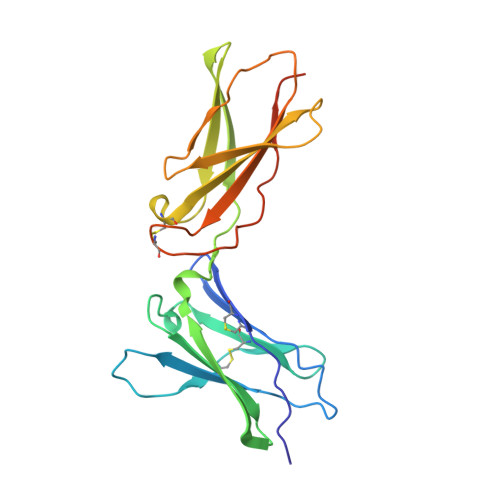Facile discovery of surrogate cytokine agonists.
Yen, M., Ren, J., Liu, Q., Glassman, C.R., Sheahan, T.P., Picton, L.K., Moreira, F.R., Rustagi, A., Jude, K.M., Zhao, X., Blish, C.A., Baric, R.S., Su, L.L., Garcia, K.C.(2022) Cell 185: 1414
- PubMed: 35325595
- DOI: https://doi.org/10.1016/j.cell.2022.02.025
- Primary Citation of Related Structures:
7S2R, 7S2S - PubMed Abstract:
Cytokines are powerful immune modulators that initiate signaling through receptor dimerization, but natural cytokines have structural limitations as therapeutics. We present a strategy to discover cytokine surrogate agonists by using modular ligands that exploit induced proximity and receptor dimer geometry as pharmacological metrics amenable to high-throughput screening. Using VHH and scFv to human interleukin-2/15, type-I interferon, and interleukin-10 receptors, we generated combinatorial matrices of single-chain bispecific ligands that exhibited diverse spectrums of functional activities, including potent inhibition of SARS-CoV-2 by surrogate interferons. Crystal structures of IL-2R:VHH complexes revealed that variation in receptor dimer geometries resulted in functionally diverse signaling outputs. This modular platform enabled engineering of surrogate ligands that compelled assembly of an IL-2R/IL-10R heterodimer, which does not naturally exist, that signaled through pSTAT5 on T and natural killer (NK) cells. This "cytokine med-chem" approach, rooted in principles of induced proximity, is generalizable for discovery of diversified agonists for many ligand-receptor systems.
- Departments of Molecular and Cellular Physiology, and Structural Biology, Stanford University School of Medicine, Stanford, CA 94305, USA; Howard Hughes Medical Institute, Stanford University School of Medicine, Stanford, CA 94305, USA.
Organizational Affiliation:





















